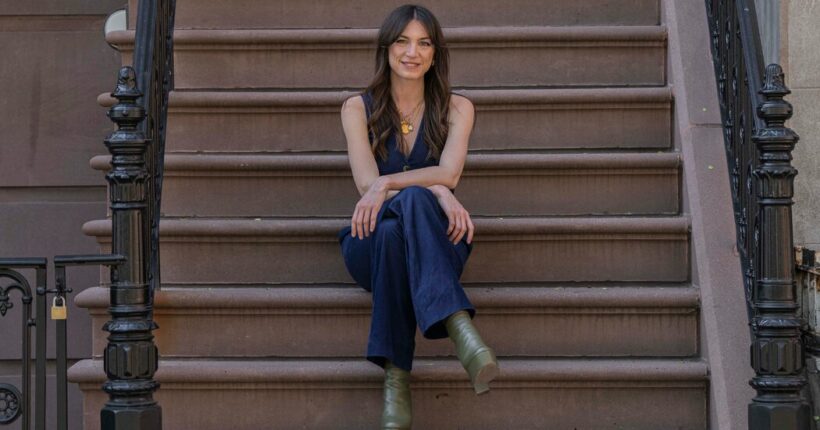On a Wednesday in March at the Museum of Modern Art in New York City, the art historian, curator and podcaster Katy Hessel lingered by Leonora Carrington’s 1953 painting “And Then We Saw the Daughter of the Minotaur.” The mysterious dreamscape depicts a white bull in a red robe, seated at a table covered in crystal spheres. Two pale children dressed in black cloaks seem to be seeking guidance from the bull, as well as a phantom spirit.
“I like the idea that there’s something happening in secret here,” said Ms. Hessel, hovering her finger near the painting’s faceless dancing apparition. As an expression of Ms. Carrington’s dual upbringing — her rebellious youth in Britain and subsequent escape to Mexico — “these hybridized figures feel like figures from two worlds in a way,” Ms. Hessel said.
Ms. Hessel, petite, with long brown hair parted in the middle, carried the U.S. edition of her forthcoming 512-page art history book, “The Story of Art Without Men,” in a white Bao Bao Issey Miyake tote slung over an Axel Arigato trench coat. Hearing Ms. Hessel’s melodious British accent and enthusiasm for the work of a female artist, another young woman, standing patiently by, approached from the corner of the room. “I’m a huge fan of your podcast,” she said.
Though it isn’t especially unusual these days for certain podcast hosts to get recognized in public, it remains less common for an art historian like Ms. Hessel. The 29-year-old polymath, who is behind the Great Women Artists podcast, newsletter and Instagram, has built a large following for encouraging art lovers and newbies alike to approach the craft’s historical canon with a raised eyebrow and a red pen.
“Certainly people are like, Oh, I’m not into art,” Ms. Hessel said of talking to strangers about her work. “But you know, I tell them if you just look at this picture, we can talk about it, and something might spark your interest.”
Ms. Hessel fell in love with art at a young age. When she was 6, she recalled seeing Louise Bourgeois’s spider at the Tate Modern Turbine Hall in London with her older sister, nine years her senior. In her teen years in London, Ms. Hessel was obsessed with self-starting teen culture mavens like Tavi Gevinson and began keeping extensive notes and diaries of exhibitions she saw. But it wasn’t until Ms. Hessel graduated with a degree in art history from University College London in 2015 when she realized how little she knew about female artists. The book she’d grown up paging through at her parents’ home, “The Story of Art” by E.H. Gombrich, featured only one woman in its 688 pages (even in its 16th edition).
In October 2015, Ms. Hessel started an Instagram account with the handle @thegreatwomenartists as a means to educate herself about the likes of Corita Kent, Amrita Sher-Gil, Deborah Roberts and more. The account, which was inspired by Linda Nochlin’s 1971 essay in Art News, “Why Have There Been No Great Women Artists?” and artist activists like the Guerilla Girls, has since amassed more than 330,000 followers. After Instagram, Ms. Hessel launched a podcast, born from her desire to meet her heroes. Now in its ninth season with over 100 episodes, Ms. Hessel has interviewed everyone from Marina Abramović — “We bonded over our love for Yorkshire tea and had some wasabi peas,” she said — to Loretta Pettway Bennett and Mary Margaret Pettway of the Gee’s Bend Quiltmakers.
Written during the pandemic, “The Story of Art Without Men” felt like a natural next step after the popularity of her other projects. Ms. Hessel doesn’t have a Ph.D., so she treated the writing of her book as an excuse to act like she was getting one. She mulled questions like: Who gets to be an artist? Who gets to be an art historian? The acknowledgments section of the book is especially long, Ms. Hessel said, because she spent so much time fact-checking with experts. “The beauty about writing it during lockdown was the fact that I had access to so many scholars who could discuss it with me,” she said.
Does creating a book entirely for non-male artists contribute to their marginalization within art history? Ms. Hessel did consider that possibility. “Of course it is contributing to putting people in a box, absolutely,” she said. “But I do think that we have to go overboard in order to make an equal society one day.” She hopes that one day in the future there will be enough gender parity and representation in the art world that children will wonder why a book like hers was ever necessary.
Wandering into a room hung with a cluster of notorious Picassos, she inadvertently kept walking. “I could tell you far more about Dora Maar than I could Picasso.”
Source: Read Full Article
